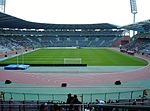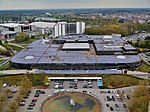Brussels Planetarium
Buildings and structures in BrusselsCity of BrusselsPlanetaria in BelgiumUse British English from January 2024

The Brussels Planetarium (French: Planétarium de Bruxelles, Dutch: Planetarium van Brussel) of the Royal Observatory of Belgium is a planetarium located on the Heysel/Heizel Plateau in Laeken (northern part of the City of Brussels). It was established during the Brussels International Exposition of 1935 as the Alberteum and is now part of the institutions of the Belgian Federal Science Policy Office.
Excerpt from the Wikipedia article Brussels Planetarium (License: CC BY-SA 3.0, Authors, Images).Brussels Planetarium
Avenue de Bouchout - Boechoutlaan, Brussels
Geographical coordinates (GPS) Address Phone number Website External links Nearby Places Show on map
Geographical coordinates (GPS)
| Latitude | Longitude |
|---|---|
| N 50.893333333333 ° | E 4.3375 ° |
Address
Planetarium
Avenue de Bouchout - Boechoutlaan 10
1020 Brussels
Belgium
Open on Google Maps









